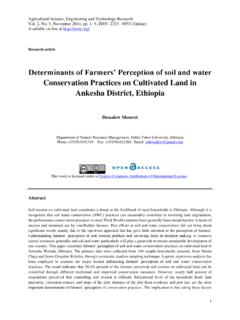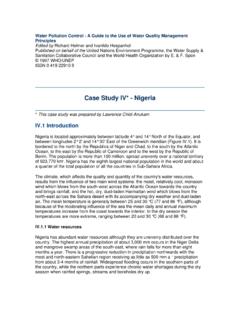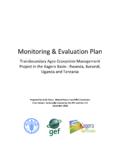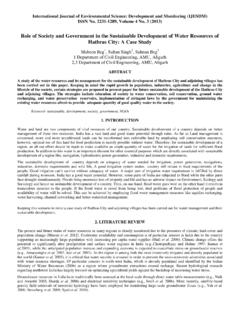Transcription of Soil and Water Conservation Techniques and Strategies for ...
1 12th ISCO Conference Beijing 2002 soil and Water Conservation Techniques and Strategies for Food Security and Poverty Alleviation Daniel Danano Box 62758 Addis Ababa, Ethiopia E-mail: Abstract: A study was undertaken to assess the constraints to sustainable soil and Water Conservation interventions and develop effective Strategies to the soil and Water Conservation program in Ethiopia.
2 The methodology used in identifying the constraints were the collection of information from the beneficiaries and field staff across the country, analyzing results of field trials, observations and review of study reports and relevant documents. Some of the major constraints identified were low awareness of the beneficiaries on the problem of soil erosion and the impact of soil Conservation measures in combating the problem, lack of genuine participation on the part of farming population, ineffective technical packages fitting to local conditions, lack of policies etc.
3 Promoting participation, formulation of sound policies, proper livestock management, formulation of appropriate technological packages, pursuing watershed planning and implementation approaches and promotion of income generating activities were the Strategies suggested to tackle these constraints. 1 Background and objective Ethiopia for the last couple of decades has faced serious ecological imbalances because of large scale deforestation and soil erosion caused by improper farming practices, destructive forest exploitation, wild fire and uncontrolled grazing practices.
4 This has resulted in a declining agricultural production, Water depletion, disturbed hydrological conditions, poverty and food insecurity. Over the past three decades, many governmental and non-governmental organizations have been involved in massive soil and Water Conservation activities. However, the results achieved in reducing soil erosion problem and improving agricultural productivity have been unsatisfactory. This study was thus conducted to assess the constraints to sustainable soil and Water Conservation interventions and develop Strategies leading to the achievement of effective Conservation practices, which improve agricultural production, help in the attainment of food security and poverty alleviation.
5 2 Methodology A field survey was conducted and information collected through structured and semi-structured questionnaire from farmers, field technical staff, and government officials at various levels including wereda administrative councils. About 650 farming households were interviewed from all the regions. Furthermore, information was gathered from focussed group discussions in selected villages. Review of reports and study documents, experience learnt from other organizations and countries through visits and study tours; and analysis of field trials made at representative Conservation sites have all been used in the study.
6 3 Results and discussions For sustainable development in soil and Water Conservation , attainment of food security and poverty alleviation the following tools, Techniques and strategy directions have been identified. Hence the findings of the study need to be considered in the plan and implementation of Conservation based development in Ethiopia. 359 Community participation, empowerment and awareness Promoting participation of the beneficiary population A methodology and mechanism has to be formulated that encourages the participation of the beneficiary population, which is an indispensable tool for sustainable management of natural resources.
7 It was seen from experiences in the past that a genuine participation of the community was lacking (over 90% of the interviewed) in most of the areas except in few. This is reflected in the reluctance to maintain Conservation measures and protecting assets. Farmers attitudes in being unwilling to take responsibilities for maintaining development activities on their own, unless they are told to do so and even sometimes want to be paid for the maintenance (95% of the interviewed) is a serious problem which should be tackled.
8 However, it is worth mentioning, the attempts being made to make the public aware of the problems of land degradation and motivate the participation in Conservation activities in the country as a whole. Yet, more work will need to be done to empower the community, foster further their involvement, and encourage them to establish local regulations and bylaws, which guarantee Conservation activities and achievements. Furthermore, the procedures worked out and practiced in handing over development activities (about 50% are handed over) to the land users are a good experience to be adopted and further enhanced.
9 For this strategy to be recognized and effectively practiced, the awareness of the farming population should be raised through education and field visits to the level that they understand the problems of natural resources degradation, take the initiatives for identifying the problems, plan and implement Conservation practices. Eventually they should assume the responsibilities for maintaining and proper utilization of the assets developed. A written document on the agreements made and the modalities for implementing the activities, maintaining protecting and managing assets created should be worked out and agreed by the beneficiary target groups.
10 In addition to this, the formation of farmers groups (men and women equally considered) in development teams is useful in making farmers work together to achieve better results and for the fact that Conservation activities are labor intensive requiring a team effort. Village Conservation committee For effective planing and implementation of soil and Water Conservation activities, the formation of a village Conservation committee is needed. The committee will have an overall responsibility of coordinating Conservation activities, organizing farmers groups, handling work tools and lead the planning of Conservation activities.






